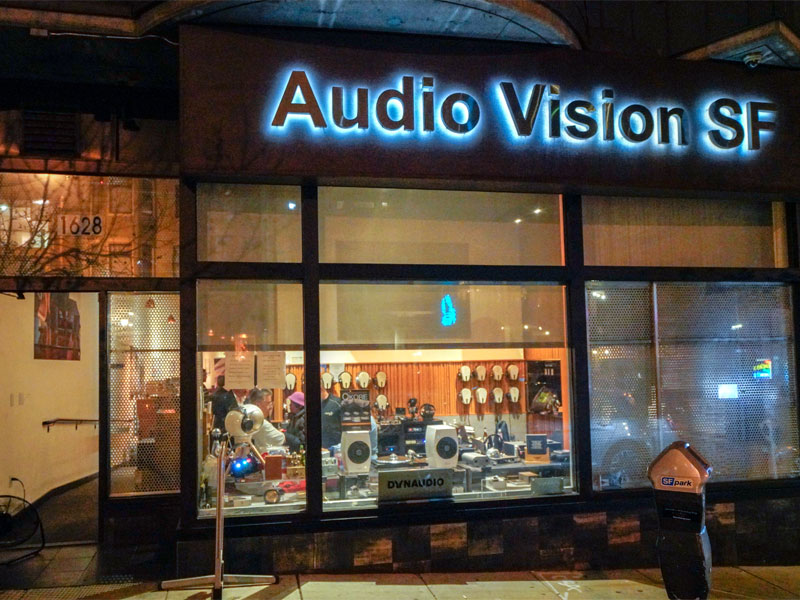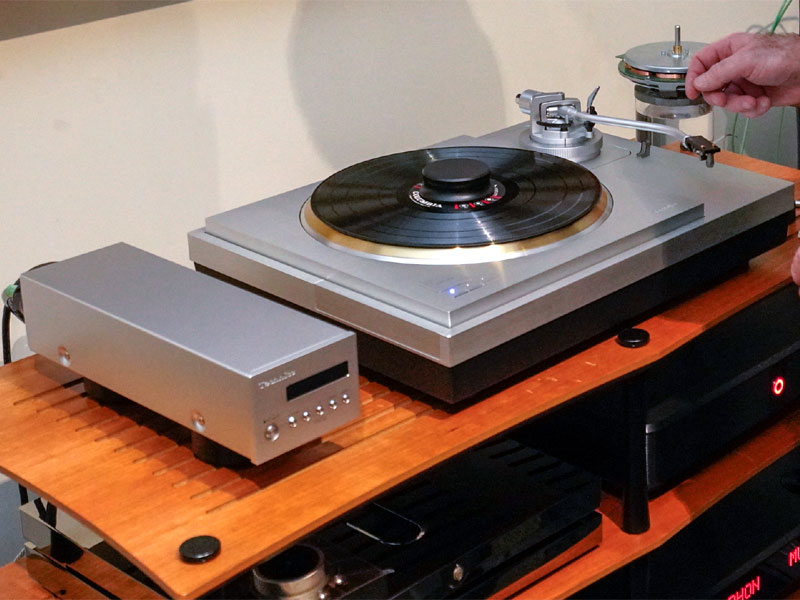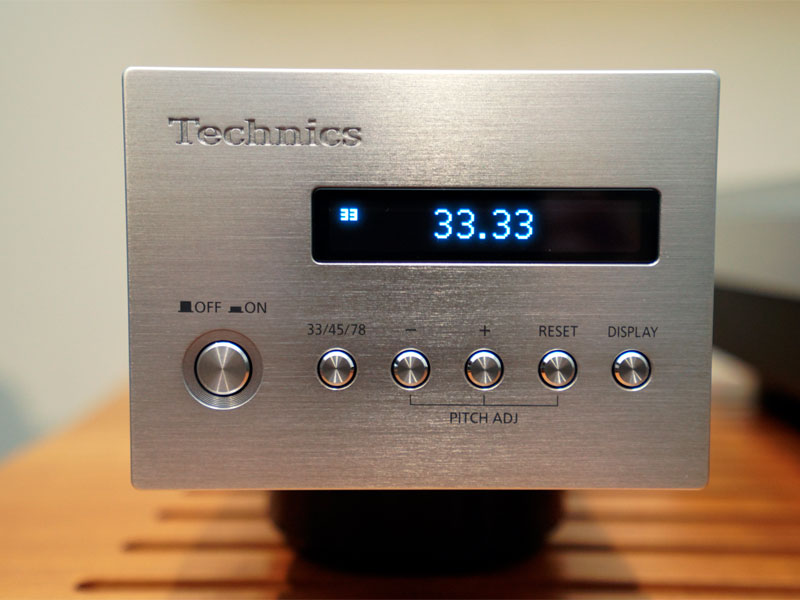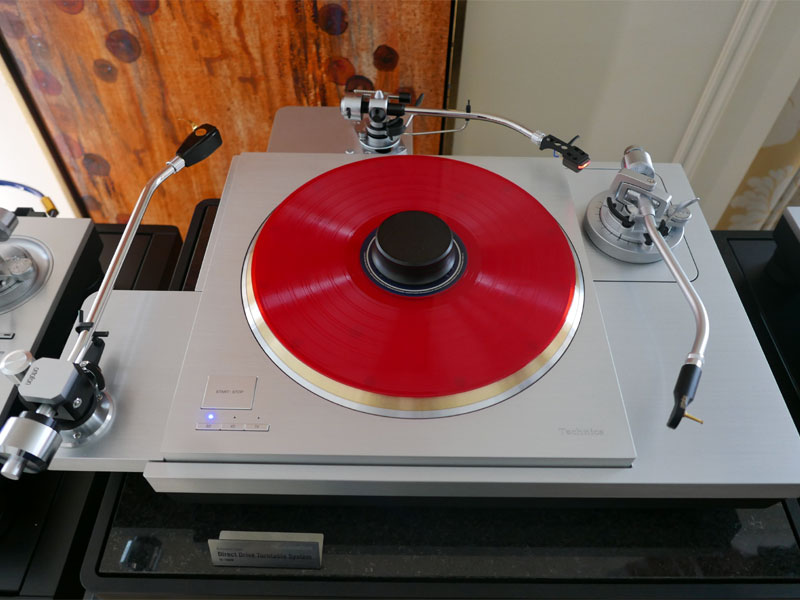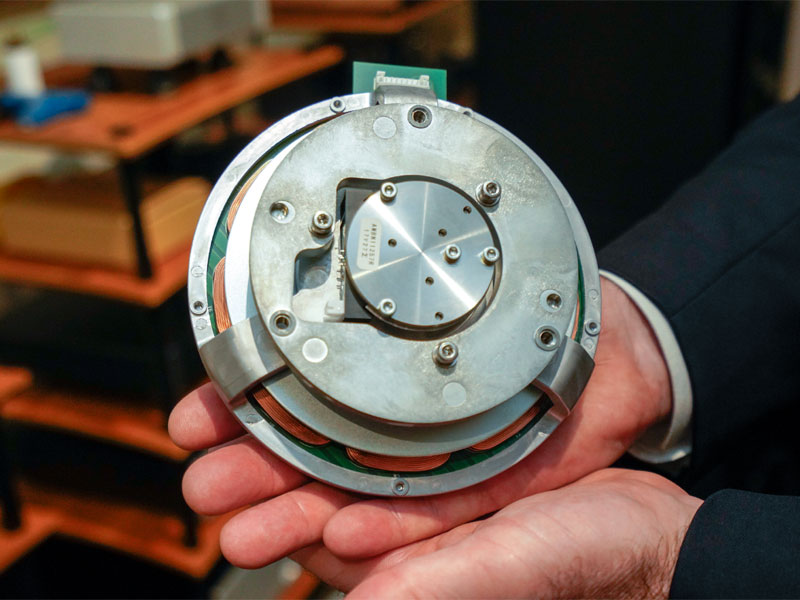Introducing the Technics SL-1000R
nyone who has spent time trying to measure and adjust the speed of a belt-drive turntable -- in other words, almost every owner of a serious turntable -- has at one time lusted for the stability of a direct-drive turntable. Thus, Audio Vision SF’s March event, launching Technics' new line of 'tables, was brimming with curious audiophiles who have either owned or are considering owning a direct-drive ‘table. Audio Vision SF (1628 California St., San Francisco, CA) is one of the city’s oldest high-end dealerships, and its space is chock-a-block with speakers, headphones and electronics. On March 22, they tucked away much of the gear to make space for a crowd of turntable fanatics.
Direct-drive turntables have been around since Matsushita (now known as Panasonic) released the original Technics SP-10 in 1970. In its various iterations, the original SP-10 had a long run -- 18 years -- and was the basis of one of the most common home-brew projects among audiophiles: the construction of a base for the owner’s drive. Even today, SP-10s are sought out on the used market. The SP-10 gave rise to the development of several over-the-top direct-drive 'tables. Denon produced several (DP-5000, DP-6000 and DP-100) for the professional/studio market. Germany contributed the legendary EMT 950 in 1976, also intended for the professional market. In 1981, Trio/Kenwood released the L-07D, an all-out design (and unrelated to the cheaper direct-drives Kenwood sold). Micro-Seiki, Nakamichi, Luxman, Goldmund and Sony all had their entries in the mostly professional transcription market, but these products remained elusive because of their marketing to professionals and their high cost. The SP-10 and other direct-drive behemoths weren’t for everyone. The benefits of direct-drive turntables built to professional standards were sufficiently alluring, however, to entice many early audiophiles to part with their Acoustic Research or Dual belt-drive turntables for a taste of the direct-drive magic. Affordable direct-drive ‘tables that were all the rage in the late 1970s were the Kenwood KD-500 and KD-600 (usually fitted out with SME tonearms). Most converts, like me, regretted the switch. Initially touted by The Abso!ute Sound, these units eventually revealed their weaknesses and drove their owners/victims back to belt drive, usually with a Linn Sondek LP12, which was released in 1972. That belt-driven turntable became so successful that direct-drive designs received relatively little attention from audiophiles for the next few decades. The 21st century has seen several serious high-end companies introduce direct-drive models, including two from Brinkmann (the Bardo and Oasis), VPI’s Classic Direct and Grand Prix Audio's Monaco 2.0. Audio Vision SF's founders, Antonio Long and Randy Johnson, were on hand to master the ceremonies. Technics, Bel Canto, YG Acoustics and Nordost were featured with their products (at various price points), which were demonstrated in several systems. Mike Marko , Nordost's regional sales manager, was running a demonstration of grounding products in one of the smaller rooms -- the Qkore grounding units and Qline grounding wires were swapped into and out of a small system to demonstrate the corrosive effects of poor grounding on even a modest system. I’ve heard this demonstration on several prior occasions, and the improvement in sound was clearly obvious with the grounding products in place. These parallel grounding devices seem to enhance not only dynamic range but also the body or three-dimensionality images, and hence the musicality of recorded music. Marko’s plug-and-play (or unplug-and-play) demonstration seemed to impress those in attendance. What was entirely new, and hence the main event, was Technics’ demonstration of its new "Reference Class" turntable. Panasonic never left the direct-drive market, and its lower-priced Technics SL-1200 Mk 2, the go-to turntable for DJs and economy systems, released in 1972, was produced in large numbers for decades. At CES 2018, Technics announced that it was reentering the high-end direct-drive market with two higher-end versions -- the SP-10R and SL-1000R -- of its classic design but incorporating current technology. At Audio Visions, Technics' Bill Voss was on hand to demonstrate the fully tricked out SL-1000R, which was used in the dealer's big room.
I’d seen photographs of the new Technics 'table before, but when I walked into Audio Vision's large demonstration room and saw the real thing, I was surprised at just how brilliant the turntable system appeared. It’s immediately obvious that Technics wants to make a good first impression -- the gorgeous architecture immediately banishes any thought of the run-of-the-mill, DJ-oriented direct-drive turntables we’ve seen over the years. The strikingly handsome base looks like billet aluminum (it’s in fact a two-layer construction of 39mm-thick aluminum and bulk molding compound). The S-shaped tonearm appears beautifully machined.
Priced at $17,999 (it was quoted as $20,000 at CES), the ‘Technics SL-1000R "Direct Drive Turntable System" is, as its full name implies, a complete turntable package with a 10" S-Type tonearm, tonearm base and Plexiglas cover. The buyer adds a cartridge and is ready to play LPs. The SP-10R "High-End Direct Drive Turntable," priced at $9999, is the exact same unit but without the tonearm, base and cover. It is made to slip into a base proportioned for the original SP-10 and thus is aimed at SP-10 owners who already have a base, or those who do not want the Technics tonearm, want the motor and think they can build a superior base. Both versions have an identical control unit for adjusting platter speed and switching speeds among 33 1/3, 45 and 78rpm. The SL-1000R weighs in at 88 pounds.
The tonearm does not have a name, as it’s not marketed separately. It is described as an "S-type universal tonearm with a lightweight, high-damping magnesium tonearm" with gimbal suspension and OFC internal wiring. Although you can mount up to three tonearms on the SL-1000R by adding two additional tonearm bases ($1499 each), Technics will not sell you another of its 'arms. You can, however, remove and replace the supplied tonearm with one of your choosing. If you wish to add additional tonearms, Technics now offers ten different pre-drilled armboards, one of which is blank to modify to your specifications. The tonearm is set up for a DIN connection, for which it supplies a stock cable. In spite of all these attractive features, the reason this turntable is causing such a stir is because of its motor. Early reports claim the motor is the most accurate direct-drive motor currently in production, based on measurements performed with the now-discontinued PlatterSpeed app. It’s not clear whether other high-end motors other than the one used by VPI form the basis of this conclusion, but even this single comparison suggests that the Technics motor is very, very special. In Technics’ own words:
Better yet, a picture of the motor shows just how massive and well-built it is.
How did the SL-1000R sound? There were too many
unfamiliar variables to make any judgment, but the system sounded quite good in a room
packed full of audiophiles and journalists trying not to spill their wine and cheese. What
was clear is that the Technics buzz is incredibly strong. At the price, the SL-1000R may
be breathing down the neck of some very serious competing 'tables. |

